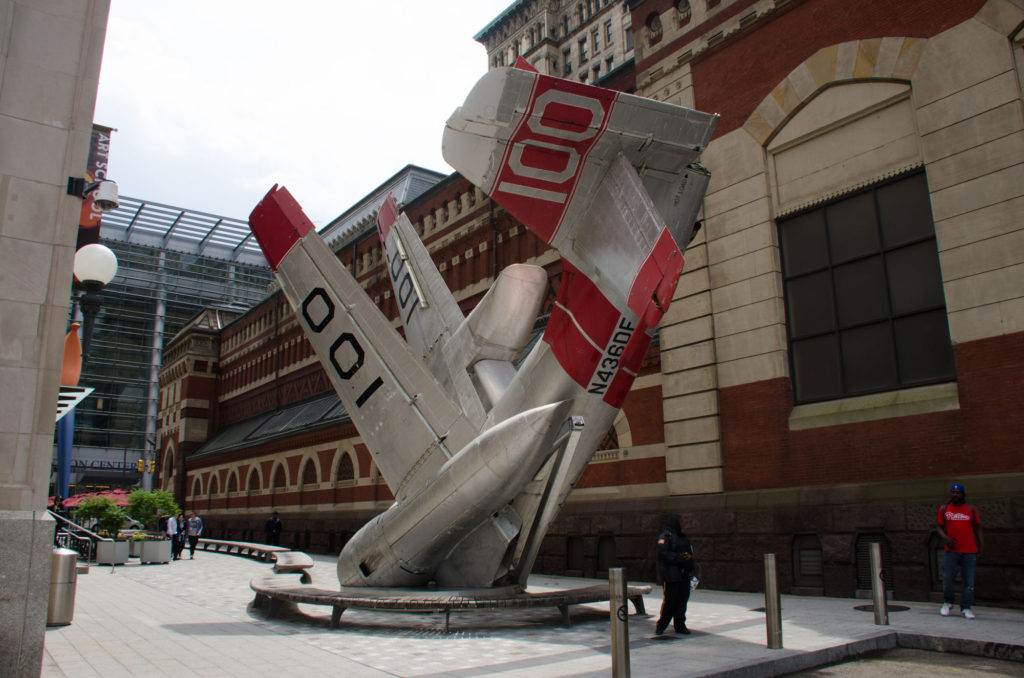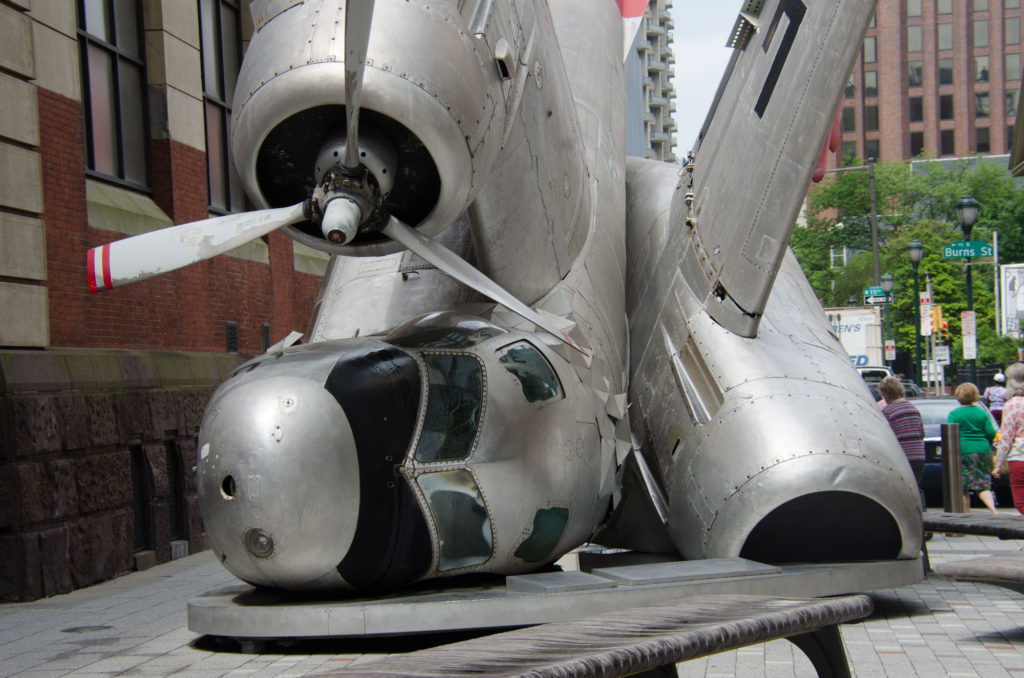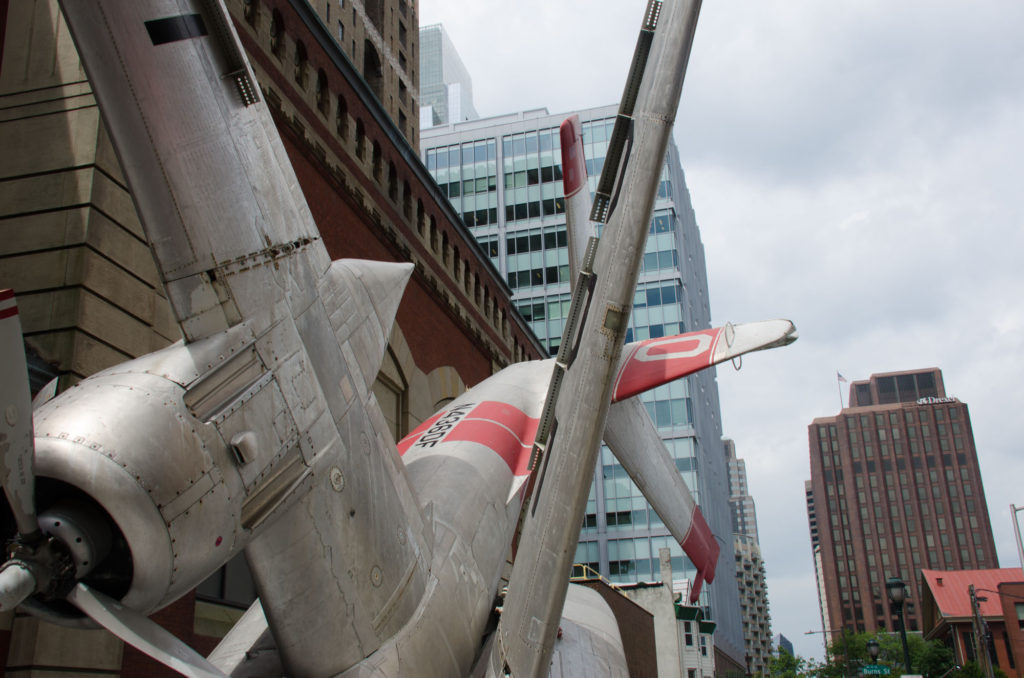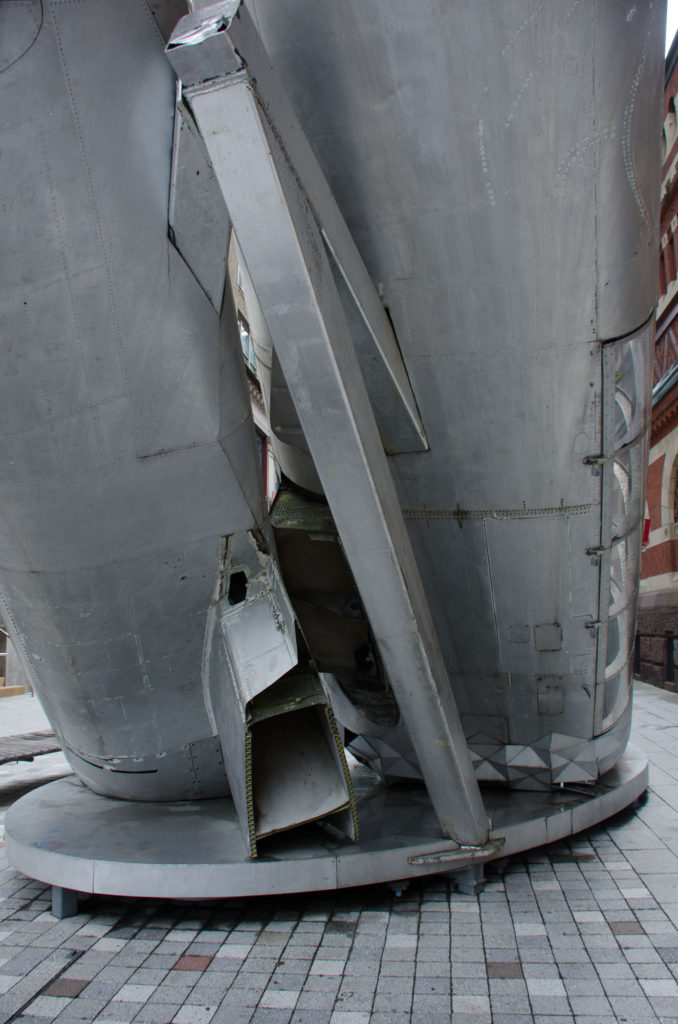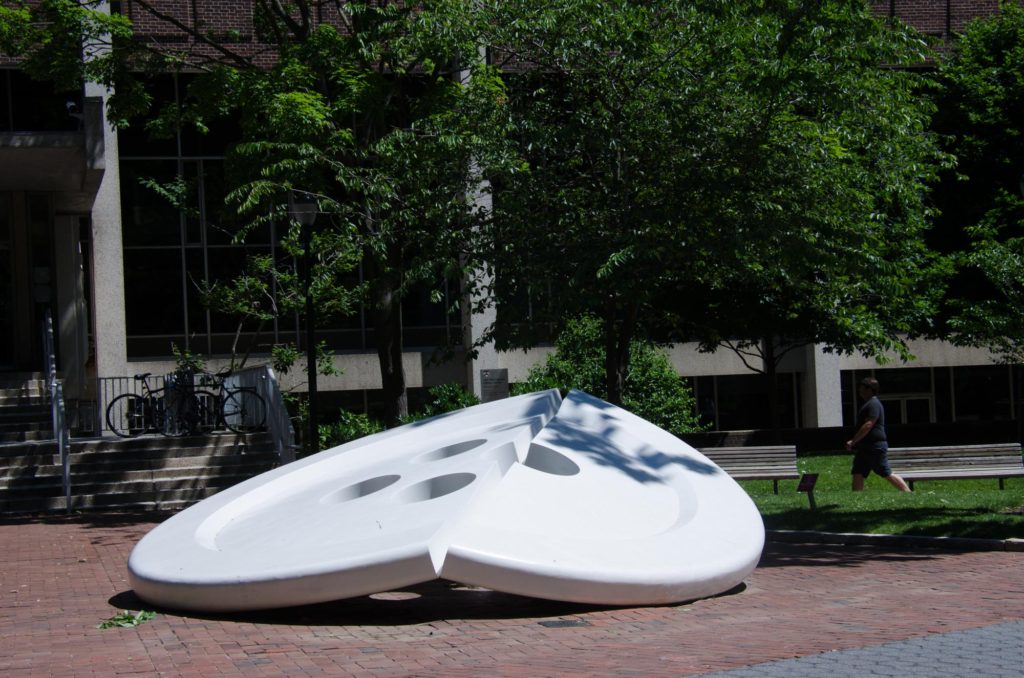Grumman Greenhouse
Lenfest Plaza
This crashed and artfully crumpled full-size airplane is titled “Grumman Greenhouse,”. The creation of 27-year-old Jordan Griska was installed in 2011.
The plane is a U.S. Navy Grumman Tracker S-2E, built in 1962. It flew from aircraft carriers. Mothballed in the 1980s, it had a second career helping to fight forest fires in California. Jordan bought it on eBay for about the same price as a cheap used car.
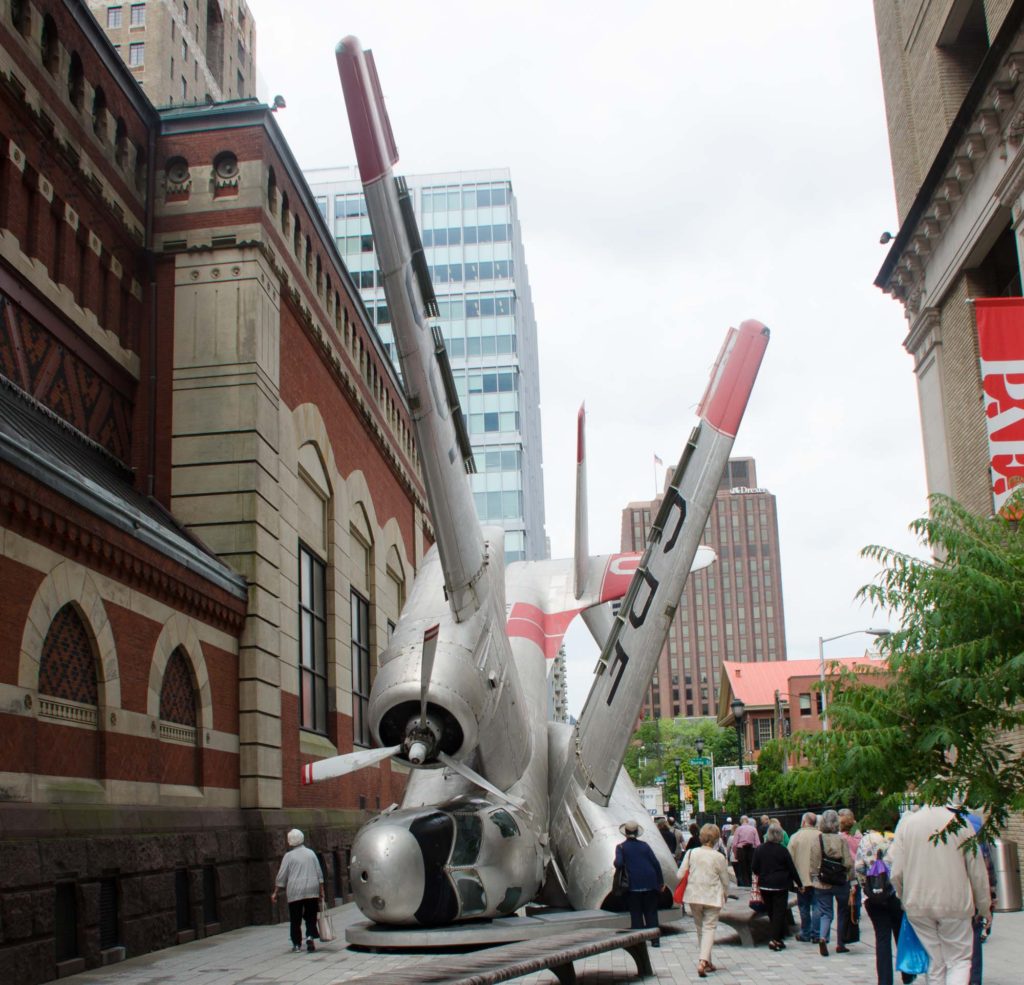 Inspired by origami, Jordan folded the Grumman to look like it had nose-dived into the ground. He then replaced its cockpit innards with a working greenhouse, lit from within by LED grow lights, powered by solar panels on the wings. “The light tells people there’s something more going on, inside,” said Jordan, who hopes it will attract people who might otherwise run away from a crashed airplane. The magenta color is a serviceable spectrum for plant growth, and Jordan liked it.
Inspired by origami, Jordan folded the Grumman to look like it had nose-dived into the ground. He then replaced its cockpit innards with a working greenhouse, lit from within by LED grow lights, powered by solar panels on the wings. “The light tells people there’s something more going on, inside,” said Jordan, who hopes it will attract people who might otherwise run away from a crashed airplane. The magenta color is a serviceable spectrum for plant growth, and Jordan liked it.
The artist, who sees his work as a metaphor for recycling and repurposing, picks up seedlings from a local nursery, raises them in the airplane for a month, then delivers the herbs, peppers, and kale to City Harvest, which feeds poor families in the region. “It’s been a learning curve to get the temperature, light, and water right,” said Jordan. “I’m not gonna let my project not survive.”
Jordan says, “It’s not anti-military, it’s not anti-firefighter,” he said. “It’s about the plants growing in the plane.”
Paint Torch
Lenfest Plaza
 Installed in August 2011 at a daring 60-degree diagonal position, the 51-feet high Paint Torch sculpture by Claes Oldenburg in Lenfest Plaza honors the act of painting—from the classical masters in PAFA’s museum to the students in PAFA’s School of Fine Arts. Paint Torch, commissioned by PAFA, stands on the point of its handle in a gravity-defying gesture. Nearby on the plaza floor is a six-foot high “glob” of paint, part of which the brush has lifted into the sky in a depiction of the act of painting a picture. The “glob” and “blip” at the tip of the brush are both illuminated from within at night.
Installed in August 2011 at a daring 60-degree diagonal position, the 51-feet high Paint Torch sculpture by Claes Oldenburg in Lenfest Plaza honors the act of painting—from the classical masters in PAFA’s museum to the students in PAFA’s School of Fine Arts. Paint Torch, commissioned by PAFA, stands on the point of its handle in a gravity-defying gesture. Nearby on the plaza floor is a six-foot high “glob” of paint, part of which the brush has lifted into the sky in a depiction of the act of painting a picture. The “glob” and “blip” at the tip of the brush are both illuminated from within at night.
Covenant
University of Pennsylvania
Locust Walk
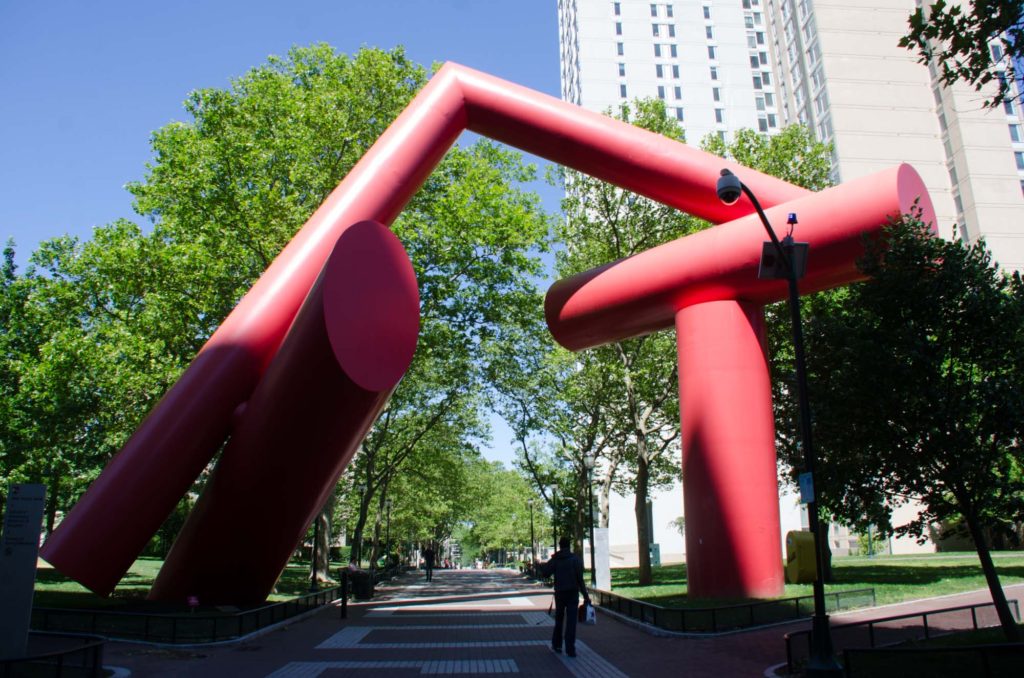 Weighing over 25 tons, Covenant, the creation of Alexander Liberman (1912-1999) was commissioned as part of the university’s fulfillment of the Redevelopment Authority’s Percent for Art requirement.
Weighing over 25 tons, Covenant, the creation of Alexander Liberman (1912-1999) was commissioned as part of the university’s fulfillment of the Redevelopment Authority’s Percent for Art requirement.
Alexander Liberman’s sculpture has been described as so “wildly asymmetrical” that every change in the viewer’s angle of perception alters the apparent axes. During his long career his sculpture became increasingly monumental, and he characterized his larger works as a kind of “free architecture” that should have the impact of a temple or cathedral. In Covenant Liberman specifically intended to convey a feeling of unity and spiritual participation. The installation in 1975 was assisted by a grant from the National Endowment for the Arts.
Split Button
University of Pennsylvania
In front of Van Pelt Library
Split Button by Claes Oldenburg cost $100,000 with $37,500 coming from the University, $375,000 from NEA and the remaining raised through contributions. It is made of reinforced aluminum, weighs 5000 pounds and meashures 16 feet in diameter.
A legend exists, mainly circulated by students at the University of Pennsylvania, that attributes The Button to the university’s founder, Benjamin Franklin. A monument of a seated Franklin stands near the sculpture; legend has it that when this man of considerable girth sat down, his vest button popped off and rolled across the University’s Locust Walk. It eventually came to a stop and split into two—hence becoming today’s sculpture.
Oldenburg, however, presents an alternative view. He once said “The Split represents the Schuylkill. It divides the button into four parts—for William Penn’s original Philadelphia squares.”
